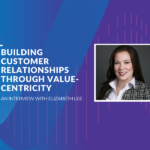Value Creation Is The Foundation Of Customer Success
In today’s subscription-based economy, you need to deliver consistent value across the entire customer lifecycle to maximize adoption, retention and expansion. To do this successfully, a unified Customer Success (CS) organization focused on value creation and a smooth hand-off from Sales to CS is vital.
To learn how CS leaders at the top of their game are optimizing value selling and success, Valuize CEO, Ross Fulton, recently joined Jeremy Evans, Global Vice President, Customer Success at Zuora, Paul Brook, Global Head of Customer Success at HashiCorp, and Manjula Talreja, Chief Customer Officer at PagerDuty, at Gainsight’s Pulse Everywhere conference. These CS heavyweights came together for a powerful discussion about how to understand customers’ needs and expectations, proactively deliver value at each stage of the customer lifecycle and effectively measure the success of your team and initiatives.
Here are 4 guiding principles that these accomplished Customer Success leaders use to define and deliver value throughout the entire customer lifecycle at PagerDuty, HashiCorp and Zuora.
Defining Achievable Value-Based Customer Outcomes
The process of value creation and realization starts with defining the value and outcomes that your customers are looking to achieve. Value will mean something different to each customer depending on their goals, their pain points and the problem your product is intended to solve for them. As your customers will ultimately define customer value, it’s crucial to involve them in the value definition process and reinforce this value throughout their journey as a customer.
According to Paul, the process of value definition at HashiCorp is two-fold: “At a macro level, we like to think of customer value in terms of how we can help our customers save money, reduce risk and influence revenue. From a Customer Success perspective, I always look at customer value as a two-sided coin: on the one side is the customer view; what is the value the customer is looking to get out of their HashiCorp investment? What are the business challenges they’re looking to solve? How do we make sure we have a success plan that reflects those goals and objectives with the right technical workstreams to deliver on the expected value?
On the other side of the coin, is the journey to value that we want to take our customers on through the adoption of foundational use cases and then advanced value-based outcome use cases. The magic happens when we can align our use cases and value-based outcomes to those business challenges that our customers are solving for and then play it back to our customers through our living customer success plan, exec dashboards and balance scorecards.”
Implement Value Delivery Throughout The Entire Customer Lifecycle
Today, the biggest question plaguing Customer Success organizations is; where in the customer lifecycle should the process of value delivery begin?
At Zuora, Jeremy says value creation begins in their pre-sales motion; “We’ve started moving a lot of this methodology from just post-sales activity into the pre-sales motion. We spend a lot more time talking to customers about what they can expect when they put ink to paper and they sign with Zuora. A lot of our delivery of value and outcomes for the customer journey start in the pre-sales process. We’re moving into a system where we can capture that and bring it into Gainsight for a more automated and repeatable process where we can take personas and start to build different paths to make it easier for CSMs to pick up customers and expand their customer portfolio. Through this process, customers get exposed to the same things pre-sales as they do post-sales so it’s as advertised when they get to my team and the post-sales motion.”
For PagerDuty, the process of value delivery begins even before the pre-sales motion. According to Manjula, ”it starts from the first conversation or interaction with the customer. You need to implement business value throughout the entire customer lifecycle, from the point they begin their trial with you. What was the value that drove them from trial to purchase? Once you ascertain that, then you go into the deployment and achievement of business value and drive expansion and renewals. Value delivery doesn’t start at the time of purchase and their transition into CS but from that very first engagement with your business.”
Verify And Measure Your Success
Measuring your value delivery efforts is crucial to making improvements and verifying that both you and your customers are on a streamlined track to success. The process of outcome verification with a customer is a work in progress in the industry and many B2B organizations are charting their own path and creating their own set of standards.
At PagerDuty, this process occurs throughout the customer lifecycle; “Value delivery and verification is a constant journey. It starts as soon as the handoff happens from Sales to CS and the first moment of software deployment and continues through to quarterly business reviews with the customer. It’s a constant validation and iteration process because the customers’ business goals are also iterative and we have to go on that journey with them,” says Manjula.
Zuora used a benchmarking tool to help measure their customers’ success. According to Jeremy, “we use a framework we call our 9 keys; we take our benchmark data from across all of our customers, anonymize it and use it as a tool to showcase customers where they sit relative to peers in their vertical or group of customers. We also use this tool to show them whether they lie above or below our core 9 areas of focus. That helps us crystalize not only deficiencies but also areas to focus on to achieve higher value and beat the benchmark. Sometimes it’s small product tweaks and sometimes it’s larger changes in the organization but it gives us a base point that we can start from to demonstrate where customers are at in their journey and then, after we’ve done the work with them, prove the buy.”
For a deeper dive into how to define, deliver and measure customer value in your organization, listen to Ross, Manjula, Paul and Jeremy’s full discussion from the 2021 Pulse Everywhere conference.
Value Should Be The Steel-Thread That Connects Your Pre- And Post-Sales Teams
Value creation and realization is the economic lifeblood of recurring revenue businesses and needs to start at an initial engagement with a prospect. Uniting your pre- and post-sales team is mission critical to driving maximum value for your customers and maximum growth for your business.
Are you ready to maximize the impact of your Customer Success organization? Read our article about how to align your teams, tools and processes around customer value creation to boost recurring revenue growth.





